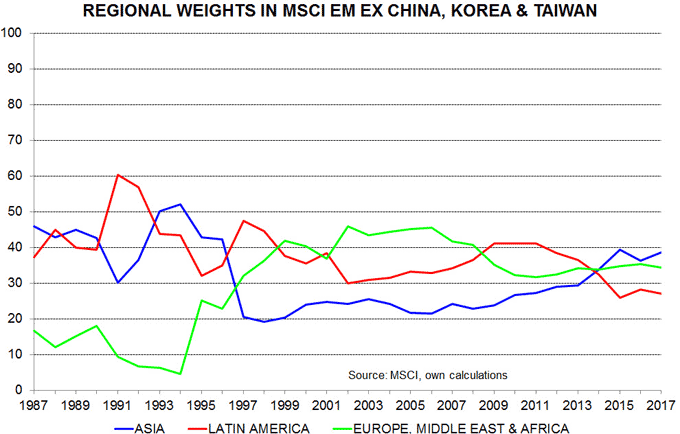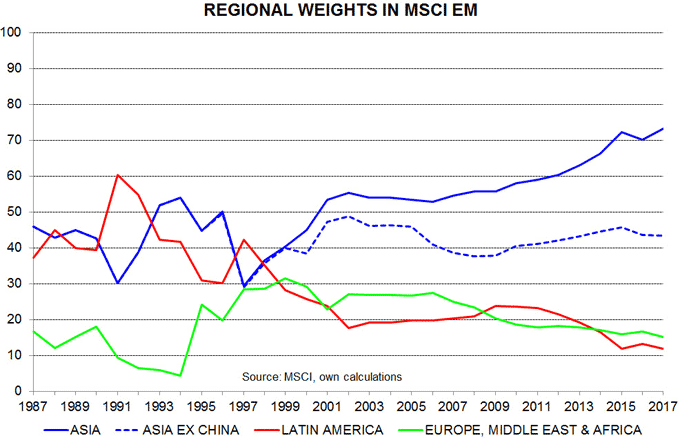The characteristics of the MSCI emerging markets (EM) equities index have changed significantly in recent decades, raising questions about its suitability as a benchmark for EM investing.
The index is now dominated by China, the weight of which rose to 33.2% on 1 June following the addition at end-May of more than 200 large-cap A shares with an inclusion factor of 2.5% of their market capitalisation.
China’s weight on 1 June, surprisingly, was not the largest single-country weight in the history of the index – Malaysia’s weight was 33.8% at the inception of the index on 1 January 1988, when there were only 10 country constituents, compared with the current 24 – see first chart.
The largest single-country weight, however, has averaged 20.5% over the 30-year history of the index – well below the current Chinese level. China’s weight, moreover, is likely to increase further – the A share factor is scheduled to rise to 5% at end-August, while it is reasonable to assume full inclusion within 10 years. (The phased inclusion of Korea and Taiwan in the 1990s / 2000s occurred over seven and nine years respectively.) MSCI previously estimated that China would account for about 42% of the index if the A shares were included fully, based on then-prevailing market capitalisations.
The rise of China has resulted in the index providing less regional diversification. At end-1999, Europe, the Middle East and Africa (EMEA) accounted for 31.5% of the index, with Latin America at 28.2%. The weights on 1 June were 13.9% and 10.6% respectively, with Asia up to 75.5%. Asia’s weight could exceed 80% if / when the Chinese A shares are fully included – second chart.
The index has also become less “emerging”. The third chart shows the relative income levels of the EM index (a market capitalisation-weighted average of the constituent countries) and selected countries. Relative income is measured by GDP per capita at purchasing power parity expressed as a percentage of the G7 level. At its inception in 1988, the index represented countries with an average income of about one-third of the G7 level. That proportion has risen to about a half, mainly reflecting the inclusion and rapid growth of Korea and Taiwan. Taiwan’s GDP per capita is now close to the G7 average while Korea’s is within the G7 range. From an economic perspective, neither country should be represented in an EM index.
Investors, arguably, should now allocate to Korea and Taiwan within the developed markets portion of their equity portfolio. Removing them from the EM benchmark, however, would further magnify China’s dominance. There is a case for separating out China, to reflect its size and unique economic characteristics, and to make explicit the allocation decision between China and the rest of EM – in the same way that investors often separate a developed markets portfolio into US and “international” buckets.
Stripping China, Korea and Taiwan from the MSCI EM index would create a benchmark with similar characteristics to the “old” EM index: GDP per capita of the benchmark constituents would be less than 40% of the G7 level – third chart – while the weights of EMEA and Latin America would be much closer to that of Asia – fourth chart.
Simon Ward, Chefökonom, Janus Henderson Investors
Weitere beliebte Meldungen:












